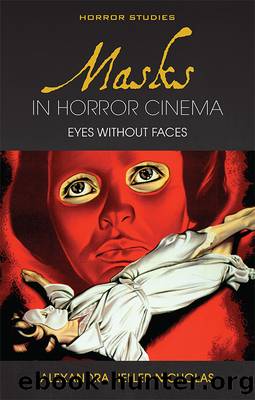Masks in Horror Cinema by Alexandra Heller-Nicholas

Author:Alexandra Heller-Nicholas
Language: eng
Format: epub
Publisher: University of Wales Press
Animal Masks and Totemism: Motel Hell (1980) and Bloody Reunion (2006)
Pigs have long been rendered symbolically across a range of cultures as objects of disgust and transgression. Islam and Judaism explicitly forbid the eating of pork in accordance with the Quran and Hebrew scripture respectively, the latter stating that ‘because it parts the hoof and is cloven-footed but does not chew the cud, [the pig] is unclean’.13 In The Politics and Poetics of Transgression, Peter Stallybrass and Allon White highlight the pig’s historical association with abjection, noting its role in Carnival: along with the rat, the pig is ‘symbolically base and abject’.14 Films like Carrie (Brian De Palma, 1976) and Daddy’s Deadly Darling (Marc Lawrence, 1972) connect pigs and abjection in the centrepieces of their respective narratives and spectacles and pig masks in horror are not rare: Benjamin Christensen’s Häxan (1929) includes pig masks and they are worn by a range of horror antagonists in films including The People Who Own the Dark (León Klimovsky, 1976), The Butcher (Kim Jin-won, 2007), Death Stop Holocaust (Justin Russell, 2009), Porkchop (Eamon Hardiman, 2010), Torment (Jordan Barker, 2013), White Settlers (Simeon Halligan, 2015) and throughout the Saw franchise (2004–17). The pig mask as a visual signifier of transgression transcends horror, from Pier Paolo Pasolini’s Porcile (1969) to Nelson Lyon’s adult art film The Telephone Book (1971).
The pig mask in Motel Hell is limited in terms of actual screen time, but its impact surpasses temporal duration, evidenced by its ubiquity in the film’s promotional materials. For Clover, Motel Hell is ‘a send-up of modern horror with special reference to Psycho and [Texas] Chain Saw [Massacre] II’, noting its pig mask-wearing villain Farmer Vincent (Rory Calhoun) is typical of the ‘sexually disturbed’ killer of the slasher film.15 For John Kenneth Muir, it is ‘a black comedy about hypocrisy, about the way in which every person, even serial killers like Farmer Vincent, tell themselves little lies to get through the day’.16 Wearing his pig-head mask and wielding a chainsaw, Vincent’s pig mask appears mostly in the film’s climax, when his brother – Sheriff Bruce Smith (Paul Linke) – confronts him in the meat-processing shed as he seeks to rescue Vincent’s victim/fiancé Terry (Nina Axelrod). Vincent’s wears the pig mask to punctuate moments where he has the greatest levels of power and control – frightening children who visit the eponymous motel, or menacing the innocent Terry. Notably, he does not wear it when tending the human ‘crop’ that he farms in his garden to produce his highly sought after small goods: these for him at least are not him flexing his dominance, but rather he speaks explicitly of ‘humane’ farming practices. He wants their deaths to be spiritually fulfilling, as ‘they’re good animals, they’re not like chickens or hogs’, bragging about his refusal to use preservatives. Capturing his victims with bear traps, he turns them into meat-producing stock, but in his mind the wearing of the pig mask reduces himself to an ‘animal’ too, the mask constructing Motel Hell as a film about ‘animals’ farming humans.
Download
This site does not store any files on its server. We only index and link to content provided by other sites. Please contact the content providers to delete copyright contents if any and email us, we'll remove relevant links or contents immediately.
The Kite Runner by Khaled Hosseini(4435)
Gerald's Game by Stephen King(3918)
The Perils of Being Moderately Famous by Soha Ali Khan(3782)
Dialogue by Robert McKee(3582)
Story: Substance, Structure, Style and the Principles of Screenwriting by Robert McKee(2985)
The 101 Dalmatians by Dodie Smith(2936)
The Pixar Touch by David A. Price(2739)
Confessions of a Video Vixen by Karrine Steffans(2674)
Fantastic Beasts: The Crimes of Grindelwald by J. K. Rowling(2543)
How Music Works by David Byrne(2525)
Harry Potter 4 - Harry Potter and The Goblet of Fire by J.K.Rowling(2416)
Slugfest by Reed Tucker(2415)
The Mental Game of Writing: How to Overcome Obstacles, Stay Creative and Productive, and Free Your Mind for Success by James Scott Bell(2393)
Wildflower by Drew Barrymore(2118)
Scandals of Classic Hollywood: Sex, Deviance, and Drama from the Golden Age of American Cinema by Anne Helen Petersen(2109)
Casting Might-Have-Beens: A Film by Film Directory of Actors Considered for Roles Given to Others by Mell Eila(2071)
Screenplay: The Foundations of Screenwriting by Syd Field(2057)
Robin by Dave Itzkoff(2005)
The Complete H. P. Lovecraft Reader by H.P. Lovecraft(1976)
